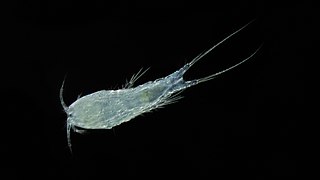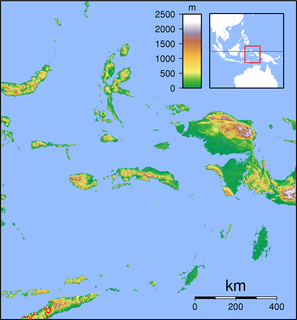
Canthocamptus is a genus of copepods that live in water from the Arctic Ocean to the Atlantic Ocean. There are over 200 different species of Canthocamptus. A number of Australian endemic species are listed as vulnerable species on the IUCN Red List, and one Brazilian species is conservation dependent.

Lake Kutubu is a lake in the Southern Highlands Province of Papua New Guinea. It lies to the east of the Kikori River, into which it eventually drains. It is about 50 km southwest of Mendi, the provincial capital. It is one of the few lakes in the country that occurs in a depression in the rugged interior mountains. It is the second-largest lake in Papua New Guinea, after Lake Murray, and, at 800 m above sea level, the largest upland lake. The area of the lake is 49.24 km², while the total catchment area is 250 km². Lake Kutubu and Lake Sentani form an ecoregion on the WWF's Global 200.

A species that is extinct in the wild (EW) is one that has been categorized by the International Union for Conservation of Nature as known only by living members kept in captivity or as a naturalized population outside its historic range due to massive habitat loss.

Misool, formerly spelled Mysol or Misol, is one of the four major islands in the Raja Ampat Islands in West Papua, Indonesia. Its area is 2,034 km². The highest point is 561 m and the main towns are Waigama, located on the island's northern coast, and Lilinta.
The lesser Papuan pipistrelle is a species of vesper bat. It can be found in Indonesia and Papua New Guinea.
Saribus jeanneneyi is a very rare species of palm tree in the genus Saribus. It is endemic to southern New Caledonia, where only one mature specimen, surrounded by a few seedlings, survives in its native habitat. The cause of its rarity in the wild is because its meristem is edible.

The common tube-nosed fruit bat is a species of megabat in the family Pteropodidae. It is found at islands north of Australia, and in Indonesia, Papua New Guinea, the Philippines and the Solomon Islands.

The great flying fox, also known as the greater flying fox or Bismarck flying fox, is a species of megabat in the genus Pteropus, found throughout lowland areas of New Guinea and in the Bismarck Archipelago. Conflicting evidence suggests that its closest relative is either the spectacled flying fox or, jointly, the Pelew and insular flying foxes. Two subspecies are recognized. At up to 1.6 kg (3.5 lb) in weight, it is among the heaviest bats in the world and the largest bat in Melanesia. It is a gregarious animal which roosts with hundreds or thousands of individuals. In part due to its wide variation in color, it has many taxonomic synonyms, including Pteropus degener, Pteropus papuanus, and Pteropus sepikensis. It may forage during the day or night in search of fruit, including figs or fruits from the family Sapotaceae. It is considered a least-concern species by the IUCN, though its numbers have been negatively impacted by what appeared to be a disease, as well as by hunting for bushmeat that occurs across its range.
Carabdytes alutaceus is an endangered species of beetle in the family Dytiscidae. It is endemic to New Caledonia, in the southwest Pacific Ocean.

Rhantus is a genus of beetle in family Dytiscidae. There are about 100 species distributed worldwide. They often live in pools and marshy habitat types. Several species have colonized oceanic islands and become endemics.
Rhantus novacaledoniae is a now extinct species of beetle in the family Dytiscidae. It was endemic to New Caledonia.
Meridiorhantus orbignyi is an extinct species of predaceous diving beetle in the family Dytiscidae. This species was formerly a member of the genus Rhantus.

Chrysotus is a genus of flies in the family Dolichopodidae. It is one of the largest genera in the subfamily Diaphorinae, with more than 460 species. However, the genus is probably paraphyletic, and possibly even polyphyletic, with respect to several related genera such as Achradocera, Falbouria and Lyroneurus.

Nartus grapii is a species of beetle in family Dytiscidae, found in the Palearctic. This species was formerly a member of the genus Rhantus.

Rhantus suturellus is a species of predaceous diving beetle in the family Dytiscidae. It is found in North America and the Palearctic.










